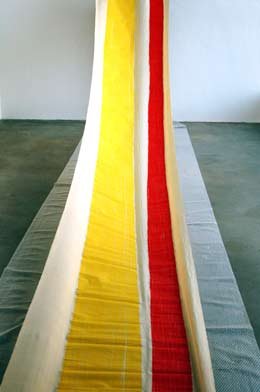Noel Forster
dal 18/3/2008 al 25/4/2008
Segnalato da
18/3/2008
Noel Forster
Chelsea Space, London
At the end of the 1960's the abstract painter embarked on a series of 'open works', which could be rolled out at different lengths, held in tension, strung hammock-like across a space or laid out on a surface such as the floor.

This exhibition is surprising not only in that it presents an important series of works not seen for over 30 years but also because these works are not in the signature style associated with the artist and therefore confound preconception.
At the end of the 1960’s the abstract painter Noel Forster (1932–2007) embarked on a series of “open works” each approximately 1m by 15m, which could be rolled out at different lengths, held in tension, strung hammock-like across a space or laid out on a surface such as the floor. These works acknowledged historical precedents such as the Chinese painted scroll, religious and political rolled texts, banners, and tapestries but they were also a contemporary challenge designed to remind us that paintings are real objects in the world.
The traditional vertical display of painting, its pictorial aspects, and its receding edges or frame remove paintings from the everyday to a kind of virtual reality. Forster’s work, by doing away with this edge or gap and by jutting out and interrupting our physical space, aimed to draw attention to the material aspects of painting and challenge notions of surface. These works were exhibited widely in the early 1970’s including venues such as the Camden Art Centre in 1971, the Kunsthalle Bern in 1973, and the Kunsthalle Basle in 1975.
Because they must be unrolled to be seen and could be used in different lengths and configurations, Noel Forster sensed that these works did not exist, to some extent, until they were handled or displayed and that it would be preferable if decisions about their display were made by someone other than the artist. Forster referred to this as “performing” or “realizing” the work. For the exhibition at CHELSEA space Director of Exhibitions, Donald Smith, invited artist Gary Woodley to co-“realize” these open works and jointly create a schema for the project. In keeping with the “open” aspect of Noel Forster’s intensions, four different scrolls will be shown, one at a time, so that there will essentially be four different shows in five weeks. The exhibition also includes a wall-based text work originally conceived for the catalogue for the exhibition 7 Aus London at the Kunsthalle Bern in 1973.
Since the 1980’s Donald Smith had been involved in a dialogue with Noel Forster about these and other related works but ironically had never experienced them first hand, in 2007 he finally persuaded Forster to exhibit them. After much planning Smith and Gary Woodley visited Noel Forster to unwrap the work (which had been in storage in France for many years), take measurements, photographs, and other notes and discuss the principles of the proposed exhibition. Noel Forster was enthusiastic and supportive of the project but tragically died less than two weeks after this studio meeting aged 75 following a long illness. CHELSEA space is therefore greatly indebted to Eileen, Stephen, Alban, and Hugo Forster for supporting the conclusion of this project.
The exhibition is accompanied by a publication including a selection of Forster’s writings from 1969 – 1975
Chelsea Space
16 John Islip Street (Chelsea College of Art and Design) - London



